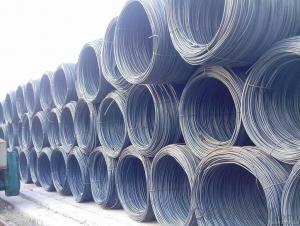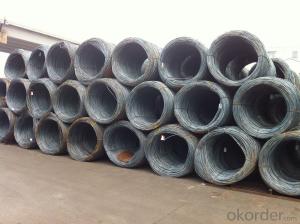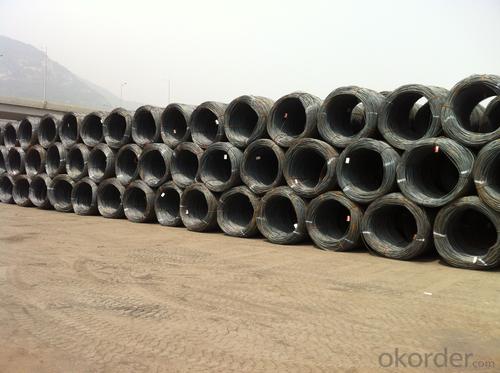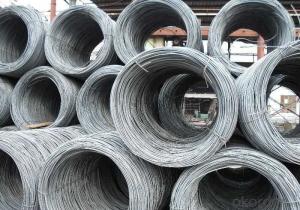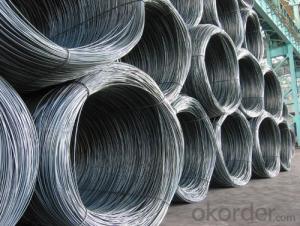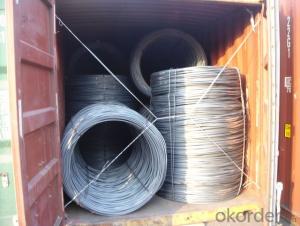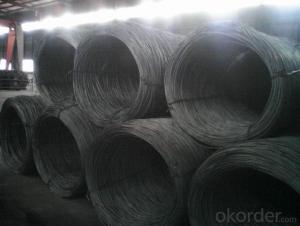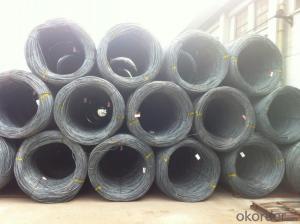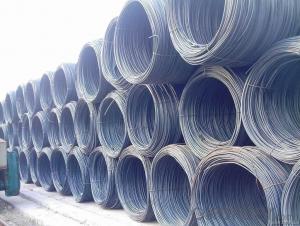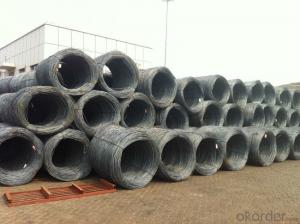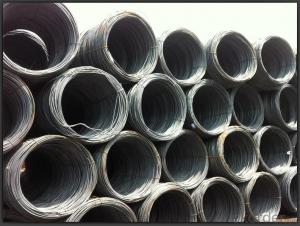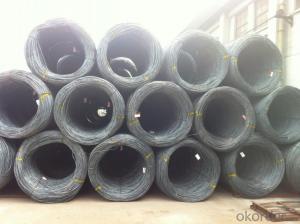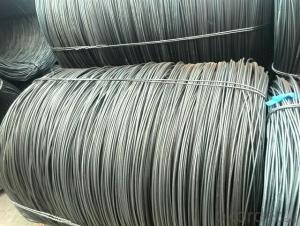Hot Rolled SAE1008 Wire Rods with High Quality
- Loading Port:
- Tianjin
- Payment Terms:
- TT OR LC
- Min Order Qty:
- 25 m.t
- Supply Capability:
- 10000 m.t/month
OKorder Service Pledge
OKorder Financial Service
You Might Also Like
Specification
OKorder is offering SAE1008 Wire Rods at great prices with worldwide shipping. Our supplier is a world-class manufacturer of steel, with our products utilized the world over. OKorder annually supplies products to European, North American and Asian markets. We provide quotations within 24 hours of receiving an inquiry and guarantee competitive prices.
Product Applications:
After hot-rolled the products shaped into coil and delivery as finished product, including round, square, rectangular, hexagonal and so on. Since most of the products are round, it is generally called wire rod. Carbon steel wire rod is widely used in construction and manufacturing. Carbon steel wire rod is mainly used for reinforcement of reinforced concrete and welded structure or reprocessed (roberts , nail, etc.) materials, especially used to produce wire drawing, welding electrode, nails, spring, electronic, precise machinery parts and so on.
Product Advantages:
OKorder's Wire Rods are durable, strong, and resist corrosion.
Main Product Features:
· Premium quality
· Prompt delivery & seaworthy packing (30 days after receiving deposit)
· Corrosion resistance
· Can be recycled and reused
· Mill test certification
· Professional Service
· Competitive pricing
Product Specifications:
Manufacture: Hot rolled
Grade: SAE1006 – SAE1008
Certificates: ISO, SGS, BV, CIQ
Length: 6m – 12m, as per customer request
Packaging: Export packing, nude packing, bundled
Grade | Chemical Composition (%) | |||||
C | Mn | S | P | Si | B | |
SAE1006B | 0.03~O.07 | 0.32max | 0.045max | 0.040max | 0.30max | 0.0008min |
Mechanical properties | ||||||
Yield strength(N/mm2) | Tensile strength(N/mm2) | Elongation (%) | ||||
250-280 | 350-380 | ≥32 | ||||
Grade | Chemical Composition (%) | |||||
C | Mn | S | P | Si | B | |
SAE1008B | 0.10max | 0.3~0.50 | 0.050max | 0.040 max | 0.15max | 0.0008 min |
Mechanical properties | ||||||
Yield strength(N/mm2) | Tensile strength(N/mm2) | Elongation (%) | ||||
≥195 | 315-430 | ≥30 | ||||
FAQ:
Q1: Why buy Materials & Equipment from OKorder.com?
A1: All products offered by OKorder.com are carefully selected from China's most reliable manufacturing enterprises. Through its ISO certifications, OKorder.com adheres to the highest standards and a commitment to supply chain safety and customer satisfaction.
Q2:What's your payment terms ?
A2: We can accept T/T,LC at sight and time LC.
Q3: Can you offer the third part inspection certificates ?
A3: Yes, we can apply third part inspection before shipping, such as SGS, BV, etc .
Images:
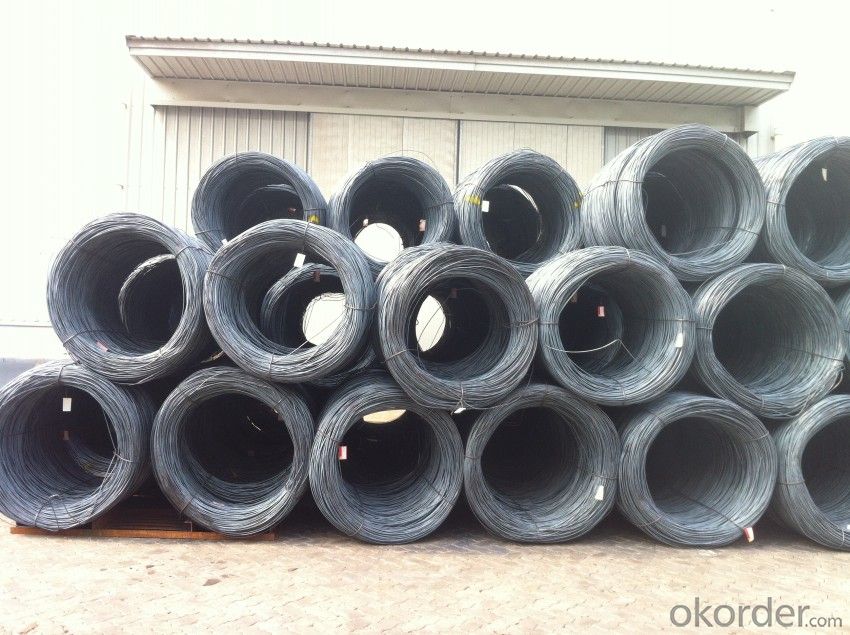
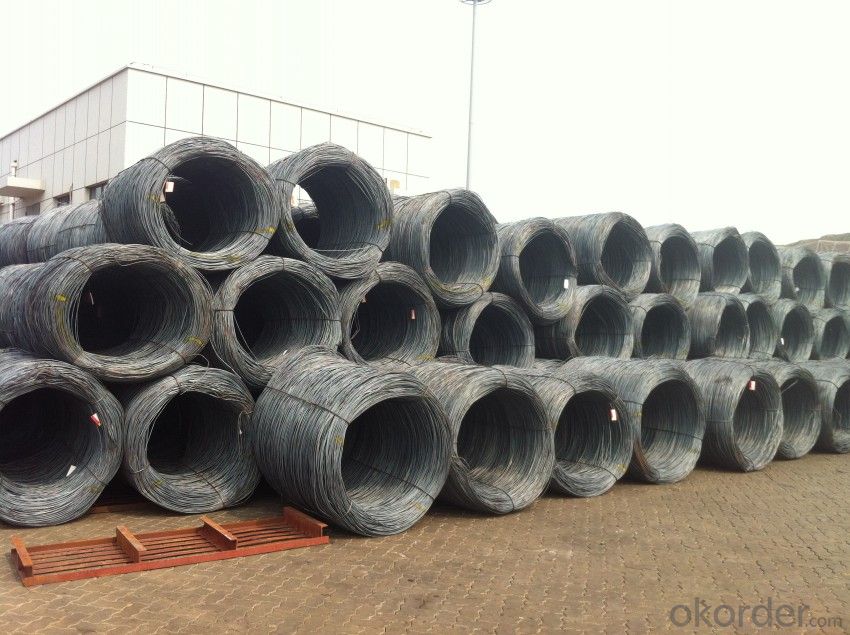
- Q: How is steel wire rod used in the manufacturing of medical devices?
- Steel wire rod is used in the manufacturing of medical devices in various ways. It can be shaped and formed into different components such as springs, coils, and meshes, which are essential for the functionality and structural integrity of medical devices. Additionally, steel wire rod is often used as a reinforcement material in surgical instruments, catheters, and orthopedic implants, providing strength and durability to these devices.
- Q: What are the different types of steel wire rod surface treatment processes?
- There are several different types of steel wire rod surface treatment processes that are commonly used in various industries. These processes are designed to enhance the properties and appearance of the steel wire rod, as well as to protect it from corrosion and other forms of damage. Here are some of the most commonly used surface treatment processes for steel wire rods: 1. Pickling: Pickling is a process that involves removing impurities, such as rust and scale, from the surface of the steel wire rod. This is typically done by immersing the wire rod in an acid solution, which dissolves the impurities and leaves the surface clean. 2. Phosphating: Phosphating is a process that involves coating the surface of the steel wire rod with a layer of phosphate. This layer provides corrosion resistance and acts as a base for subsequent surface treatments, such as painting or powder coating. 3. Galvanizing: Galvanizing is a process that involves coating the surface of the steel wire rod with a layer of zinc. This layer provides excellent corrosion resistance and can be applied through either hot-dip galvanizing or electroplating methods. 4. Electroplating: Electroplating is a process that involves depositing a thin layer of metal, such as zinc or chrome, onto the surface of the steel wire rod. This layer provides enhanced corrosion resistance and can also improve the appearance of the wire rod. 5. Coating: Coating is a process that involves applying a thin layer of protective material, such as paint or powder coating, onto the surface of the steel wire rod. This layer provides corrosion resistance and can also enhance the appearance of the wire rod. 6. Passivation: Passivation is a process that involves treating the surface of the steel wire rod with a chemical solution to remove any free iron or other contaminants. This process helps to prevent corrosion and improves the passive film on the surface of the wire rod. These are just a few of the many different types of surface treatment processes that can be used for steel wire rods. The specific process chosen will depend on the desired properties and requirements of the wire rod, as well as the intended application.
- Q: How does the diameter of steel wire rod affect its strength?
- The diameter of a steel wire rod directly affects its strength. Generally, a larger diameter wire rod will have higher strength compared to a smaller diameter wire rod. This is because a larger diameter rod has a greater cross-sectional area, allowing it to withstand higher loads and stresses without breaking or deforming.
- Q: What are the major trends in the steel wire rod industry?
- The steel wire rod industry is currently being shaped by several significant trends. Firstly, there is a growing demand for steel wire rods across various industries such as construction, automotive, and manufacturing. This increased demand can be attributed to factors like population growth, urbanization, and global infrastructure development. Secondly, there are notable technological advancements taking place within the industry. These innovations aim to improve manufacturing processes, enhance wire rod quality, and reduce production costs. Automation, robotics, and data analytics are among the key technological trends that are revolutionizing the industry. Additionally, there is a shift towards more sustainable practices in the steel wire rod industry due to increasing environmental concerns. Companies are adopting energy-efficient technologies, reducing emissions, and implementing recycling programs to minimize their environmental impact. This trend is driven by both regulatory requirements and the industry's commitment to sustainability. Furthermore, the industry is experiencing market consolidation, as larger companies acquire smaller players and form strategic partnerships. This consolidation is driven by the need to optimize production capacities, expand global reach, and achieve economies of scale. Mergers and acquisitions are reshaping the competitive landscape of the industry. Lastly, steel wire rod manufacturers are increasingly focusing on product diversification to remain competitive. They are developing a wide range of wire rod products with varying specifications to cater to the diverse needs of different industries. Customization and flexibility in manufacturing are becoming crucial factors for success in the industry. Overall, these trends in the steel wire rod industry are driving it towards a more efficient, sustainable, and customer-centric future.
- Q: What are the different types of wire mesh for automotive filters made from steel wire rod?
- There are several different types of wire mesh used for automotive filters that are made from steel wire rod. Some common types include plain weave mesh, twill weave mesh, and Dutch weave mesh. Each type of wire mesh has its own unique characteristics and is used for different applications within automotive filters.
- Q: How is steel wire rod used in the manufacturing of wire for garage door springs?
- The production of wire for garage door springs relies heavily on steel wire rod. This crucial component is typically made from carbon or alloy steel and is carefully selected for its high quality. It serves as the raw material for creating the wire used in garage door springs. To produce wire for garage door springs, the steel wire rod goes through a series of procedures. Initially, it is drawn through a sequence of dies to decrease its diameter and increase its length. This drawing process imparts the wire with strength and flexibility, enabling it to withstand the tension and compression forces that garage door springs experience. Once the wire has been drawn to the desired diameter, it undergoes heat treatment to further enhance its mechanical properties. This involves subjecting the wire to specific temperatures and cooling rates, resulting in improved strength and durability. This step is crucial for ensuring that the wire can endure the repetitive cycles and heavy loads associated with garage door operations. After the wire has been heat-treated, it undergoes a surface treatment process to enhance its resistance to corrosion. This may involve applying a protective coating such as zinc or a polymer coating to prevent rust and corrosion. This is important for maintaining the performance and longevity of the garage door springs. Finally, the wire is coiled into the desired length and diameter, ready to be used in the manufacturing of garage door springs. It is fed into specialized machinery that shapes it into a helical coil, which is the typical form of a garage door spring. In conclusion, steel wire rod is of utmost importance in the production of wire for garage door springs. Through processes such as drawing, heat treatment, and surface treatment, the resulting wire possesses the necessary strength, flexibility, and corrosion resistance required for reliable and durable garage door springs.
- Q: How are steel wire rods used in the production of tire cords?
- Steel wire rods are used in the production of tire cords by being transformed into a high tensile strength wire that is then twisted and coated with rubber. These cords are embedded within the tire structure, providing reinforcement and improving its durability, stability, and resistance to punctures and impacts.
- Q: What are the main challenges in steel wire rod production?
- Some of the main challenges in steel wire rod production include maintaining consistent quality and specifications, controlling the dimensions and surface finish of the wire rod, ensuring proper heat treatment and metallurgical properties, managing the high energy consumption and environmental impact associated with the production process, and addressing the global competition and market fluctuations in the steel industry. Additionally, ensuring the safety of workers and optimizing production efficiency are also key challenges in this sector.
- Q: What are the main factors influencing the choice of steel wire rod delivery time?
- The choice of steel wire rod delivery time is influenced by several key factors. Firstly, the availability and accessibility of raw materials such as iron ore, coal, and scrap metal play a significant role in the production process and ultimately impact the delivery time. Secondly, market demand for steel wire rods is an important factor to consider. Increased demand may result in longer production and delivery times, while low demand may allow for quicker delivery. The production capacity of the steel mill or manufacturer is also crucial. Limited capacity or operating at full capacity can lead to longer fulfillment times, whereas high production capacity can result in shorter delivery times. Logistical factors, including transportation and shipping, can further impact delivery time. Delays or disruptions in the transportation network can prolong the delivery process, and the distance between the steel mill and the customer's location can also affect delivery time. Lastly, external factors such as weather conditions, labor strikes, or unforeseen events can cause disruptions in the production process and affect the overall delivery timeline. In conclusion, the choice of steel wire rod delivery time is influenced by factors such as raw material availability, market demand, production capacity, logistical considerations, and external events. Manufacturers and customers need to take these factors into account when planning for the delivery of steel wire rods.
- Q: How is steel wire rod used in the manufacturing of wire ropes for elevators?
- Steel wire rod is used as the raw material in the manufacturing process of wire ropes for elevators. It is first drawn into thin wires and then twisted together to form strands. These strands are then further twisted and combined to create a strong and durable wire rope, which is used to support the weight and movement of elevator systems. The high tensile strength and flexibility of steel wire rod make it an ideal choice for ensuring the safety and reliability of elevator operations.
Send your message to us
Hot Rolled SAE1008 Wire Rods with High Quality
- Loading Port:
- Tianjin
- Payment Terms:
- TT OR LC
- Min Order Qty:
- 25 m.t
- Supply Capability:
- 10000 m.t/month
OKorder Service Pledge
OKorder Financial Service
Similar products
Hot products
Hot Searches
Related keywords

